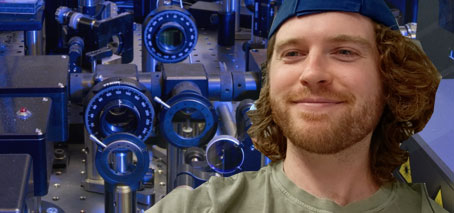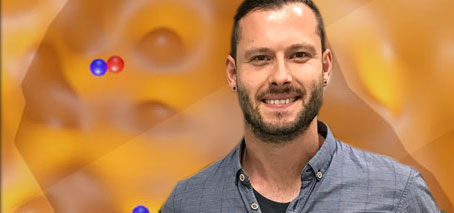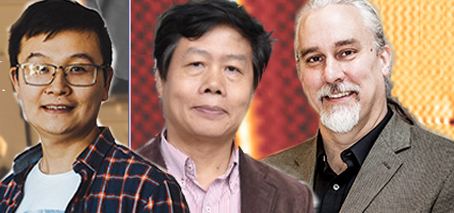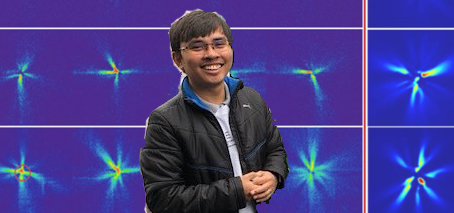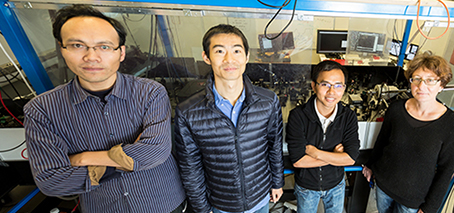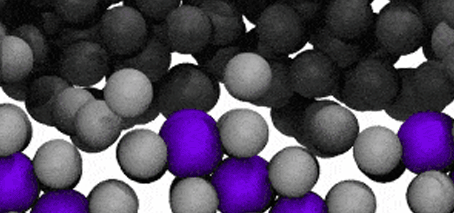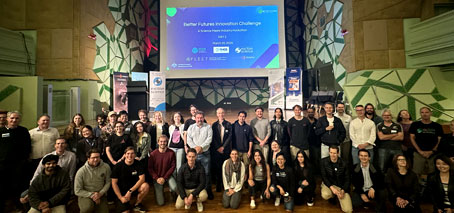Two-quantum multidimensional coherent spectroscopy (2Q-MDCS) quantifies precise biexciton binding energy Applications in future devices based on biexcitons in TMDCs A rare spectroscopy technique performed at Swinburne University of Technology directly quantifies the energy required to bind two excitons together, providing for the first time a direct measurement of the biexciton binding energy in WS2. As well as improving our fundamental …
FLEET Schools: The Exciton-Polariton
Sandwich-style construction: towards ultra-low-energy exciton electronics
New microcavity construction technique allows observation of robust, room-temperature exciton transport Polariton performance optimised by maximising photon-exciton energy exchange, minimizing the damage to monolayer A new ‘sandwich-style’ fabrication process placing a semiconductor only one atom thin between two mirrors has allowed Australian researchers to make a significant step towards ultra-low energy electronics based on the light-matter hybrid particles exciton-polaritons. The …
Honours Project: Excitonic superfluidity in electron-hole bilayers
Superconductivity and superfluidity are macroscopic quantum phenomena that are observed at low temperatures. Bringing them to room temperatures is the Holy Grail in physics. One prospective system is a double layered semiconductor structure with spatially separated electrons and holes (holes are empty electronic states that can be treated as particles with positive charges). Attractive Coulomb interactions can bind them to …
Exploring non-Hermitian physics with exciton polaritons
Prof Elena Ostrovskaya Australian National University the Research School of Physics, the Australian National University Exciton polaritons are hybrid light-matter bosons formed by excitons in semiconductors strongly coupled to microcavity photons. Sufficiently strong optical pumping can drive exciton-polaritons to a macroscopically occupied coherent state similar to a Bose-Einstein condensate. The same optical pump that injects polaritons into the system and …
Invited: Exciton-polaritons and exciton-polariton lattices
About the presenter PI Prof Sven Höfling oversees the design and fabrication of highly customised semiconductor samples for Research Theme 2 on exciton and exciton-polariton systems, as well as contribute his extensive expertise in all aspects of exciton-polariton physics.
Long-lived populations of momentum- and spin-indirect excitons in monolayer WSe2
In monolayer WSe2, the ground-state exciton is dark (D exciton, spin-indirect), and the valley degeneracy allows low-energy dark momentum-indirect excitons (XK exciton) to form. Interactions between the dark excitons and the optically accessible bright exciton (X) are likely to determine X exciton’s optical properties at high power and limit the ultimate exciton densities be achieved. However, so far, little is …
Interactions and correlations in exciton-polariton systems
I will give an update on recent theoretical progress in understanding the nature of interactions in exciton-polariton systems. About the presenter CI A/Prof Meera Parish develops many-body theories that span electron-hole systems and ultracold atomic gases. In Research Theme 2, she is investigating the fundamental properties of exciton-polariton condensates, while in Research Theme 3, she is studying quantum systems out of …
Coherent dynamics and excitation density dependence in exciton-polaritons system
About the presenter Tatek Lemma is a PhD student working with CI Jeff Davis in FLEET’s Research Theme 3 and in Research theme 2. For his PhD, he is working on the investigation of topological phase transition in a 2D semiconductor using the state-of-the-art Coherent multidimensional spectroscopy.
Towards long-lifetime excitons in 2D semiconductors
About the presenter Daniel McEwen is an Honours student working with CI Michael Fuhrer at Monash University.
Ultrafast Exciton-Polariton Dynamics in Microcavity Structures
About the presenter Mitko Oldfield is an experimental physicist specialising in terahertz time-domain spectroscopy and exciton-polariton condensation, working with Dr Agustin Schiffrin and Dr Gary Beane at Monash University within FLEET’s research theme 2 and research theme 3. Mikto’s research focuses on forming a polariton condensate in high Q-factor microcavities through the use of a terahertz pumping beam generated via …
Measurement of the non-Hermitian topological invariant in perovskite-based exciton polaritons
About the presenter Eliezer Estrecho studies the behaviour of exciton-polaritons as part of FLEET’s research theme 2, exciton superfluids, working with Elena Ostrovskaya at the ANU. He is currently studying condensation of polaritons in gallium-arsenide-based microcavities using single-shot experiments and large optically induced traps. He is also working on creating polariton condensates using atomically-thin materials.
FLEET Seminar: Nina Voronova – Quantum hydrodynamics of cold exciton gases and ultrafast Rabi-oscillating vortices in exciton-polariton condensates
Dr Nina Voronova National Research Nuclear University, Moscow Engineering Physics Institute All welcome. Download seminar flyer here. Abstract: Excitons and exciton-polaritons are bosonic quasiparticles that can demonstrate high degree of spatial coherence and quantum properties, and at the same time the ability to propagate on macroscopic distances, thus presenting a perfect solid-state platform for studying many-body effects. On top of …
Experimental observation of a new class of materials: excitonic insulators
First observation of excitonic insulator New exotic state was first predicted in 1960s A University of Wollongong / Monash University collaboration has found evidence of a new phase of matter predicted in the 1960s: the excitonic insulator. The unique signatures of an excitonic insulating phase were observed in antimony Sb(110) nanoflakes. The findings provide a novel strategy to search for …
First snapshot of exciton-polariton condensation process
First snapshot of exciton-polariton Bose-Einstein condensation (BEC) in an inorganic semiconductor Unique opportunity to understand details of BEC without statistical averaging Key to fundamental understanding of exciton-polaritons An ANU advance provides never-before-achieved ‘snapshot’ of Bose-Einstein condensation. Previously, observations of exciton-polaritons in a Bose-Einstein condensate were limited to statistical averaging over millions of condensation events. ‘Snapshot’ imaging of polaritons forming a …
MCN Tech Ops Seminar: Bose-Einstein Condensation of exciton-polaritons in 2D materials
Bose-Einstein Condensation of exciton-polaritons in 2D Mterials Tinghe Yun Monash University All welcome! Abstract: The project is aiming at the excitonic dissipationless system, towards the room temperature superfluidity. Bose-Einstein condensation (BEC), which is the physical phenomena of bosonic particle coherence, is regarded as the typical superfluidy. Exciton-polaritons, the result of strong coupling between photon and exciton, is a kind of …
Exciton superfluids
Chiral flow: twisting exciton-polariton condensates at exceptional points
Outstanding problem in exciton-polariton physics resolved using exceptional points at ANU Chirality of mode at EP opens future research avenues for exciton-polariton physics Researchers at ANU recently proved a novel method for generating orbital angular momentum states (vortices), with a topological charge that is ensured by an exceptional point. Recent studies at the ANU resolve an outstanding problem in exciton-polariton …
Puzzling results explained: a multiband approach to Coulomb drag and indirect excitons
Taking a multiband approach explains ‘electron-hole reverse drag’ and exciton formation Mystifying experimental results obtained independently by two research groups in the USA seemed to show coupled holes and electrons moving in the opposite direction to theory. Now, a new theoretical study has explained the previously mysterious result, by showing that this apparently contradictory phenomenon is associated with the bandgap …
Monash: Indirect excitons and exciton-polaritons in 2D heterostructures
Application close 18 February 2018 We seek an experimental physicist or materials scientist with expertise in van der Waals heterostructures of atomically thin materials, nanofabrication techniques, and electrical and/or optical measurements. The fellow will fabricate and characterise novel atomically thin semiconductor heterostructures for the observation of exciton and exciton-polariton condensation. The fellow will be working with Prof Michael Fuhrer at …
ANU: Exciton polaritons in atomically thin materials – 2 Level B/C positions
Applications close 31 Dec 2017. We are seeking two Level A/B Academic positions in experimental physics of exciton polaritons. The Research Fellows will take primary responsibility for the construction and maintenance of the experimental apparatus and daily operation of the laboratory. The candidates will be expected to have an in-depth experience in experimental exciton-polariton physics, spectroscopic experiments with semiconductor microcavities, and time-resolved …
Research in Exciton Superfluids
FLEET researchers undertake various research projects in the area of Exciton Superfluids. If you have a project that would fit this theme, find information about a potential supervisor here: A/PROF. MEERA PARISH Theory of strongly correlated phenomena in ultracold atomic gases and electron systems Superconductivity and superfluidity Lowdimensional systems Magnetotransport A/PROF. QIAOLIANG BAO Atomically thin optical materials (graphene, 2D transition …
ANU: Exciton polaritons in 2D atomically thin materials
Supervisors: A/Prof. Elena Ostrovskaya and A/Prof. Andrew Truscott Atomically thin transition metal dichalcogenides represent a perfect 2D “flatland” platform for creating excitons with large binding energies and coupling them to light. Strong coupling to light and formation of exciton polaritons in open and monolythic microcavities has been very recently reported by several groups around the world. This project will aim …
ANU: Non-equilibrium quantum condensation of microcavity exciton polaritons
Supervisors: A/Prof. Elena Ostrovskaya and A/Prof. Andrew Truscott Exciton polaritons are bosonic composite particles that are part light and part matter. They are composed of photons and excitons (electron/hole pairs) forming in semiconductor microcavities in the strong light-matter interaction regime. Akin to ultracold neutral bosonic atoms, polaritons can undergo Bose-Einstein condensation. In a Bose-Einstein condensate (BEC), millions of bosons occupy …
Exciton superfluids
FLEET News
FLEET News in June 2024 includes FLEET landing event, stay in touch: Friends of FLEET, upcoming conferences and more. You can sign up for FLEET news here. Catch up on previous versions of the FLEET newsletter below. May 2024 includes FLEET landing event, the new legacy Centre website, dynamic surfaces at RMIT, internship report from ANSTO and quantum sensing funding. …
FLEET Landing celebrates Centre achievements
Around 140 FLEET members, friends and partners gathered at Monash this week at the FLEET Headquarters to celebrate the Centre’s achievements. Funded in 2017, FLEET was officially launched at the same venue, Monash New Horizons Centre, on 12 June 2018. Guests include current members, alumni, collaborators and stakeholders, all of whom have contributed and supported FLEET in its seven-year journey. …
FINESS2024 Finite temperature non-equilibrium superfluid systems
Present your work at FINESS The FINESS workshop series aims to bring together a critical mass of theoretical and experimental expertise at the forefront of research in the fields of degenerate ultra-cold matter, polariton-exciton condensates, as well as strongly correlated and open quantum systems. The central aims of FINESS are: To seed the development of theoretical approaches for finite-temperature non-equilibrium …
Surfaces on the move: dynamic liquefaction
The boundary between solid metal and liquid metal can be much less ‘solid’ than we ever suspected. RMIT researchers have discovered that the liquid-solid boundary can fluctuate back and forth, with metallic atoms near the surface breaking free from their crystal lattice. Observing a metal-alloy mass solidifying in a sea of liquid metal, the team was able to observe a …
Better Futures Industry Challenge 2024
Faster ways to respond to emergencies and ultra-sensitive quantum seismometers for earlier detection of earthquakes, were two ideas that emerged from teams of intrepid researchers from five Centres of Excellence who competed in the inaugural Better Futures Innovation Challenge to solve critical industry problems. Industry partners for the deep-tech hackathon had access to researcher skills spanning the fields of physics, …

